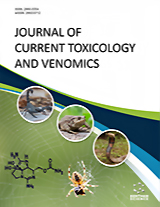Abstract
Introduction: Venom allergens have been identified in the venom of scorpion, snake, bee, wasp, etc. Some allergy reactions in humans may refer to the venom allergens.
Aim: Phylogenetic analysis of venom allergens from the transcriptome of Hemiscorpius lepturus scorpion was the main aim of the study.
Methods: Seven venom allergens: HLAllergen1, HLAllergen2, HLAllergen3, HLAllergen4, HLAllergen5, HLAllergen6, and HLAllergen7 have been identified in the venom of Hemiscorpius lepturus scorpion using venom gland transcriptome analysis. Primary, secondary and tertiary structures of the identified venom allergens were predicted using ExPASy ProtParam, PSIPRED, and SWISS MODEL servers. Phylogenetic tree was constructed using MEGA 11 software through neighbor-joining method with 1000 bootstraps.
Results: Structure analysis of identified venom allergens showed a molecular weight of between 46 to 52 kDa. Tertiary structure results showed that all predicted 3-D structures were in a normal range. Phylogenetic tree analysis showed that HLAllergen 3, 4 and 5 were formed single clades and HLAllergen 1, 2, 7, and 6 other clades.
Conclusion: However, further studies using proteomic analysis of H. lepturus are needed to confirm and compare with transcriptome data.
[http://dx.doi.org/10.1016/j.actatropica.2008.05.021] [PMID: 18579104]
[http://dx.doi.org/10.1016/j.toxicon.2009.09.012] [PMID: 19799924]
[http://dx.doi.org/10.1016/j.toxicon.2007.07.018] [PMID: 17854855]
[http://dx.doi.org/10.1016/j.toxicon.2010.05.008] [PMID: 20493200]
[http://dx.doi.org/10.14202/vetworld.2020.296-303] [PMID: 32255972]
[http://dx.doi.org/10.1016/j.toxicon.2009.11.010] [PMID: 19931296]
[http://dx.doi.org/10.1016/j.toxicon.2019.12.154] [PMID: 31887316]
[http://dx.doi.org/10.1042/BJ20061404] [PMID: 17291197]
[http://dx.doi.org/10.1111/j.1742-4658.2008.06607.x] [PMID: 18699777]
[http://dx.doi.org/10.1016/j.toxicon.2011.09.010] [PMID: 21967811]
[http://dx.doi.org/10.1016/j.toxicon.2016.11.261] [PMID: 27914888]
[http://dx.doi.org/10.1016/j.toxicon.2016.11.247] [PMID: 27845058]
[http://dx.doi.org/10.1159/000024440] [PMID: 11060481]
[http://dx.doi.org/10.1385/CRIAI:30:2:109] [PMID: 16645223]
[http://dx.doi.org/10.1080/15569543.2022.2080223]
[http://dx.doi.org/10.1016/j.peptides.2013.10.021] [PMID: 24184590]
[http://dx.doi.org/10.1042/BSR20130052] [PMID: 23721518]
[http://dx.doi.org/10.1371/journal.pone.0127883] [PMID: 26020943]
[http://dx.doi.org/10.3390/toxins8120367] [PMID: 27941686]
[http://dx.doi.org/10.1016/j.toxicon.2016.11.256] [PMID: 27889600]
[http://dx.doi.org/10.1016/j.toxicon.2016.11.251] [PMID: 27867095]
[http://dx.doi.org/10.1016/S0166-6851(01)00374-7] [PMID: 11704277]
[http://dx.doi.org/10.1016/j.toxicon.2007.10.003] [PMID: 18023835]
[http://dx.doi.org/10.1016/j.coi.2015.07.001] [PMID: 26210895]









